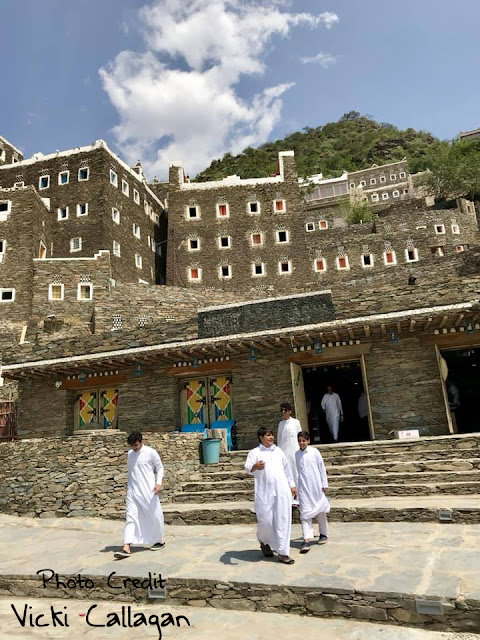The city of Abha is the capital of the Asir Region located in the southwestern corner of Saudi Arabia and is rich in cultural heritage. It is more than a mile high in elevation up in the mountains, close to the Red Sea to the west and the country of Yemen to the south. Baboons are native to the region, dwelling in the national parks in the area.
Many Saudis from around the country flock to Abha in the summer due to its cooler moderate climate. Abha also gets more rainfall than most of the kingdom and boasts rich agricultural plateaus. The highest peak of Saudi Arabia is located in Abha. It's called the Jabal Al-Sooda, or Black Mountain, and its height measures an astounding 3.3 kilometers, which is over 2 miles high!
The old traditional architecture of Abha consists of buildings made of rocks and mud. Many are more than 300 years old. The architectural style of Abha was greatly influenced by Yemeni construction.
Art is important and popular in most regions of Saudi Arabia, and Abha is abundant with art. It could be said that the area is more colorful in its dress, architecture, and art than other more conservative areas of the kingdom.
The Al Miftaha Art Village at the King Fahad Cultural Center attracts many visitors and offers exhibits of all kids of artwork, ranging from paintings and sculptures to archaelogical treasures, handmade crafts and woven items by local artisans, as well as a variety of sourvenirs.
Arabic calligraphy features prominently in a lot of Saudi art. If you look closely at the painting above, you can see how the Arabic script is incorporated into the formation of the male figures on the right.
The painting above is reminiscent of the clothing, hats, and style of Mexican or South American figures.
I love the eyes of the above painting.
The remaining photos focus on the traditional wall painting art by female artists called Al Qatt, an artform that has been passed down through generations in the Asir region of Saudi Arabia. Al Qatt utilizes mainly primary colors and geometric shapes and symbols.















The hats on the two women are most likely the conical ones worn by women in the Yemen. I learned this when I read Freya Stark's travels in the Yemen in the 20's - 40's. The clothing is also similar to that period.
ReplyDeleteOne of the bad things about modern life and the technology behind it is how it homogenizes culture. You see it in the US. The rural accents are dying out. So, are other aspects of rural life.
ReplyDeleteWhile not the same, you see a similar thing in Saudi Arabia. New buildings could have been designed by someone in Europe of Japan.
So, it is enjoyable to see artwork that could only have been designed in Saudi Arabia.
I love the cultural heritage of Saudi Arabia. It depicts true Islamic values.
ReplyDeleteSlowly reading all your story posts. You share a beautiful world I may never see in person. - I've saved the youtube interviews to watch later -
ReplyDeleteand, I keep meaning to share how much i enjoy the different ways script is used - it speaks to my heart - even if my mind can't access it. The art work astonishes . . . and, i keep wanting to tell you how the business signs intrigue me . . . sometimes it looks "choppy" - like someone "telling it like it is." Sometimes it flows, like water over stones in a brook. . . . ALWAYS you capture my imagination . . . so much Beauty. Thank you, Thank you, Thank you!